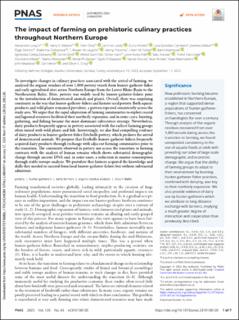The impact of farming on prehistoric culinary practices throughout Northern Europe
Lucquin, Alexandre; Robson, Harry K.; Oras, Ester; Lundy, Jasmine; Moretti, Giulia; González Carretero, Lara; Dekker, Joannes; Demirci, Özge; Dolbunova, Ekaterina; McLaughlin, T. Rowan; Piezonka, Henny; Talbot, Helen M.; Adamczak, Kamil; Czekaj-Zastawny, Agnieszka; Groß, Daniel; Gumiński, Witold; Hartz, Sönke; Kabaciński, Jacek; Koivisto, Satu; Linge, Trond Eilev; Meyer, Ann-Katrin; Mökkönen, Teemu; Philippsen, Bente; Piličiauskas, Gytis; Visocka, Vanda; Kriiska, Aivar; Raemaekers, Daan; Meadows, John; Heron, Carl; Craig, Oliver E.
Journal article, Peer reviewed
Published version

Åpne
Permanent lenke
https://hdl.handle.net/11250/3122655Utgivelsesdato
2023Metadata
Vis full innførselSamlinger
Originalversjon
Proceedings of the National Academy of Sciences of the United States of America. 2023, 120 (43), e2310138120. 10.1073/pnas.2310138120Sammendrag
To investigate changes in culinary practices associated with the arrival of farming, we analysed the organic residues of over 1,000 pottery vessels from hunter-gatherer-fisher and early agricultural sites across Northern Europe from the Lower Rhine Basin to the Northeastern Baltic. Here, pottery was widely used by hunter-gatherer-fishers prior to the introduction of domesticated animals and plants. Overall, there was surprising continuity in the way that hunter-gatherer-fishers and farmers used pottery. Both aquatic products and wild plants remained prevalent, a pattern repeated consistently across the study area. We argue that the rapid adaptation of farming communities to exploit coastal and lagoonal resources facilitated their northerly expansion, and in some cases, hunting, gathering, and fishing became the most dominant subsistence strategy. Nevertheless, dairy products frequently appear in pottery associated with the earliest farming groups often mixed with wild plants and fish. Interestingly, we also find compelling evidence of dairy products in hunter-gatherer-fisher Ertebølle pottery, which predates the arrival of domesticated animals. We propose that Ertebølle hunter-gatherer-fishers frequently acquired dairy products through exchange with adjacent farming communities prior to the transition. The continuity observed in pottery use across the transition to farming contrasts with the analysis of human remains which shows substantial demographic change through ancient DNA and, in some cases, a reduction in marine consumption through stable isotope analysis. We postulate that farmers acquired the knowledge and skills they needed to succeed from local hunter-gatherer-fishers but without substantial admixture.
